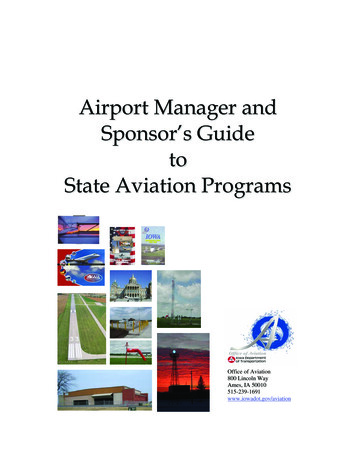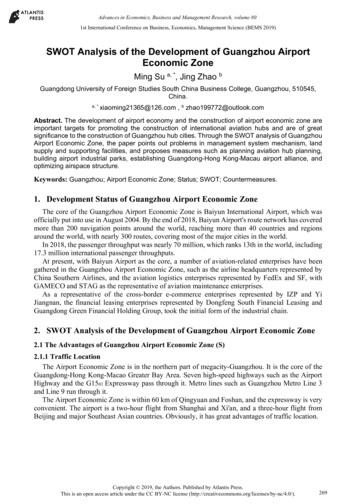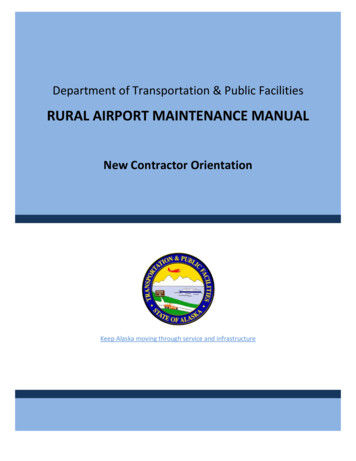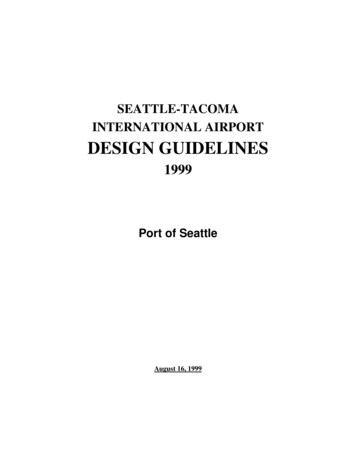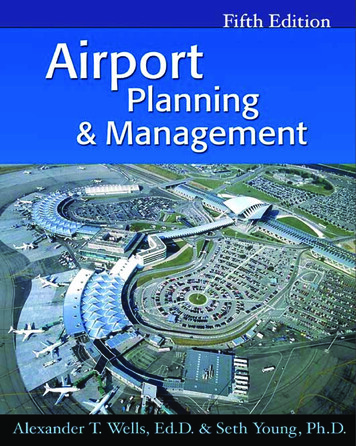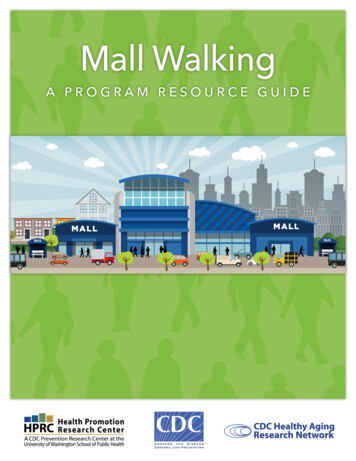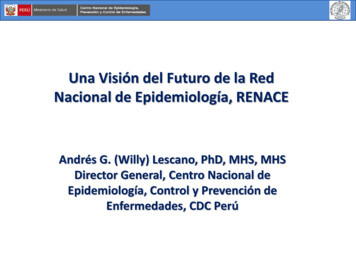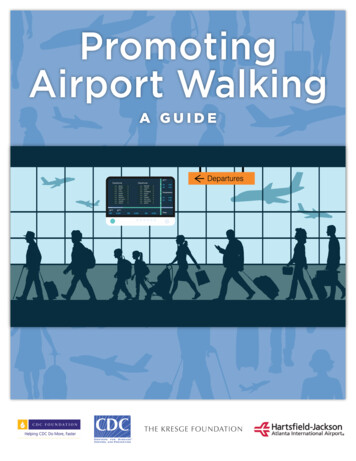
Transcription
PromotingAirport WalkingA GUIDE
December 4, 2015
ContentsSectionPageWelcome to the Airport Walking Guide .1Introduction .2Why Walk? .3Why Promote Walking in Your Airport? .5Considerations for Promoting Walking inYour Airport .7Keys to Success . 11References . 12Appendices . 13
AuthorsU.S. Centers for Disease Control and Prevention, National Center forChronic Disease Prevention and Health Promotion, Division of Nutrition, Physical Activity,and Obesity, Physical Activity and Health BranchGinny M. Frederick, MSPrabasaj Paul, PhD, MPHJohn D. Omura, MD, MPHJanet E. Fulton, PhDSuggested Citation:Frederick, G.M., Paul, P., Omura, J.D., Fulton, J.E. Promoting Airport Walking: A Guide.Atlanta, GA, U.S. Centers for Disease Control and Prevention; irportguide.pdfThe findings and conclusions in this report are those of the authors and do not necessarilyrepresent the official position of the Centers for Disease Control and Prevention.P R O MOT ING AIRPORT WA LKIN G: A GUIDE ii
AcknowledgementsPromoting Airport Walking: A Guide is a product of the Centers for Disease Control and Preventionand was supported by funding from the Kresge Foundation and administration by the NationalFoundation for the Centers for Disease Control and Prevention.A. Jill Wagner, MA, at IconoGraph Designs, provided the design for Promoting Airport Walking:A Guide, and produced the document.Special thanks to the following individuals who greatly contributed to the Walk to Fly Study and theconceptualization and design of Promoting Airport Walking: A Guide.U.S. Centers for Disease Control and Prevention, National Center for Chronic DiseasePrevention and Health Promotion, Division of Nutrition, Physical Activity, and Obesity,Office of the DirectorJanet L. Collins, PhDDeborah A. Galuska, PhDKresge FoundationDavid Fukuzawa, MDivNational Foundation for the Centers for Disease Controland PreventionBernice Bronson, MPHHartsfield-Jackson Atlanta International AirportTracy GilbertReese McCranieKathleen SullivanMyrna WhiteJon YeeP R O MOT ING AIRPORT WA LKIN G: A GUIDE iii
Welcome to theAirport Walking GuideEach day, millions of Americans travelthrough the nation’s airports todestinations around the world. Becausemillions of Americans travel through thecountry’s airports each day, they are good placesfor promoting healthy habits. Encouragingwalking in your airport, when it is an option, mayhave numerous benefits to your airport and thetravelers you serve, including:nExposure to airport amenities or advertisingnOpportunities to promote physical activity ina large and diverse populationnThis guide is primarily intended to be a resourcefor airport managers who want their airportto encourage healthy habits and improve thecustomer experience. The strategies discussedhere are most effective in airports with areaswhere travelers can choose between differenttransportation modes, such as taking a train orshuttle, or walking. Motivational signs placed inthese areas can help encourage travelers to walk.This guide was developed as a result of the Walkto Fly Study to encourage walking, instead ofriding the Plane Train in Hartsfield-JacksonAtlanta International Airport. See Appendix A foran overview of this study.P R O MOT ING AIRPORT WA LKIN G: A GUIDE 1
IntroductionThe purpose of this guide is to inform readersof the benefits of promoting walking inairports when it is an option and how to usesigns to do so. Topics covered include:nBenefits of walking for healthnBenefits of walking for your airportnUsing signs to encourage walking at pointsof decision in your airportToday, many airports have trains or shuttlesthat take travelers from one area of the airportto another. At some airports, these mechanizedtransportation systems are necessary becausetravelers cannot walk from one gate or terminalto another based on the layout or design ofthe airport. However, in airports where it ispossible for travelers to get from place to placeby walking, encouraging this option at the pointwhere travelers make this decision may providemany benefits to the traveler and your airport.The information in this guide will focus onpromoting walking in your airport by usingmotivational signs that encourage travelers towalk at locations where they have the optionto walk or use mechanized transportation. Theuse of such signs is a recommended strategyto increase stair use.1 With this strategy,motivational signs are placed at locations whereindividuals must make a decision between anactive or sedentary mode of transportation,such as taking the stairs as opposed to riding anescalator or elevator.1,5Motivational signs can be used to encouragewalking in airports when it is an option.At many airports, trains or shuttles are availablefor travelers to reach different areas of the airport.In the Success Story section of this guide(Appendix A), you can see how this concepthas been successfully applied in the Walk to FlyStudy conducted at Hartsfield-Jackson AtlantaInternational Airport. Here, motivational signswere placed at the location where travelers mustdecide whether to board the train, or walk alongthe pedestrian walkway to reach their gate.P R O MOT ING AIRPORT WA LKIN G: A GUIDE 2
Why Walk?Physical activity is an important part ofa healthy lifestyle that can help peoplereduce their risk for chronic diseasessuch as hear t disease, type 2 diabetes, and somecancers.2 It can also help those living with suchdiseases manage their conditions.3Current federal physical activity guidelinesrecommend that adults avoid inactivity andmore specifically, engage in at least 150 minutesper week of moderate-intensity aerobic physicalactivity, or 75 minutes a week of vigorousintensity aerobic physical activity, or an equivalentcombination.2Walking is a physical activity that most peoplecan do to meet the aerobic physical activityguidelines.2 When done in bouts of at least 10minutes, walking in your airport can help peoplemeet guidelines. Shorter bouts of walking canhelp people begin to make physical activity partof their daily routine.Promoting walking is also a priority of theSurgeon General, as addressed in Step It Up!The Surgeon General’s Call to Action to PromoteWalking and Walkable Communities.4P R O MOT ING AIRPORT WA LKIN G: A GUIDE 3
Why Walk?From the 2008 Physical Activity Guidelines for AmericansKey Guidelines for AdultsnAll adults should avoid inactivity. Some physical activity is better than none, and adults whoparticipate in any amount of physical activity gain some health benefits.nFor substantial health benefits, adults should do at least 150 minutes (2 hours and 30minutes) a week of moderate-intensity, or 75 minutes (1 hour and 15 minutes) a week ofvigorous-intensity aerobic physical activity, or an equivalent combination of moderate- andvigorous-intensity aerobic activity. Aerobic activity should be performed in episodes of atleast 10 minutes, and preferably, it should be spread throughout the week.nFor additional and more extensive health benefits, adults should increase their aerobicphysical activity to 300 minutes (5 hours) a week of moderate-intensity, or 150 minutesa week of vigorous-intensity aerobic physical activity, or an equivalent combination ofmoderate- and vigorous-intensity activity. Additional health benefits are gained by engagingin physical activity beyond this amount.nAdults should also do muscle-strengthening activities that are moderate or high intensityand involve all major muscle groups on 2 or more days a week, as these activities provideadditional health benefits.Key Guidelines for Children and AdolescentsnnChildren and adolescents should do 60 minutes (1 hour) or more of physical activity daily.nAerobic: Most of the 60 or more minutes a day should be either moderate- or vigorousintensity aerobic physical activity, and should include vigorous-intensity physical activityat least 3 days a week.nMuscle-strengthening: As part of their 60 or more minutes of daily physical activity,children and adolescents should include muscle-strengthening physical activity on atleast 3 days of the week.nBone-strengthening: As part of their 60 or more minutes of daily physical activity,children and adolescents should include bone-strengthening physical activity on at least3 days of the week.It is important to encourage young people to participate in physical activities that areappropriate for their age, that are enjoyable, and that offer variety.P R O MOT ING AIRPORT WA LKIN G: A GUIDE 4
Why Promote Walkingin Your Airport?Airports are great places to promotewalking. The airport environment is freefrom many of the barriers that preventtravelers from walking in their community suchas inclement weather, safety concerns, andcomfort.6-8 This gives your airport a uniqueopportunity to serve travelers not only as atransportation hub, but a place where they canget physical activity while traveling.The potential benefits of promoting walking inyour airport may include:When fewer travelers use a train or shuttle theybecome less crowded and more accessible forthose who use them out of necessity.b. Exposure to AmenitiesPromoting walking gives travelers theopportunity to see more of the amenities yourairport has to offer. Depending on the layoutof your airport, travelers who walk from onedestination to another may pass retail stores,restaurants, art exhibits, advertisements, andother attractions.a. Customer ServiceProviding travelers with information aboutwalking options in the form of signs mayhelp them more easily navigate, and be morecomfortable in your airport. They may also enjoythe feeling of having a choice in how they getfrom one area of the airport to another.Providing travelers with signs may help them feelmore comfortable in your airport.Encouraging walking may increase travelers’exposure to some of your airport’s amenities.P R O MOT ING AIRPORT WA LKIN G: A GUIDE 5
Why Promote Walking in Your Airport?c. Emergency OperationsSigns that promote walking options can alsobe useful in emergencies. In such instances,travelers who would not normally choose to walkmay need to do so. Having signs with walkinginformation in place may decrease confusionwhile helping to direct travelers to a safe area.While walking signs should not be relied on asthe only emergency signage in your airport, theymay complement emergency signage. They canalso help travelers find their way when the trainor shuttle is out of service.d. Employee WellnessSigns to encourage walking can also play a part inhelping your employees to increase their physicalactivity, thus incorporating a healthy habit intotheir daily routine. This could complement theairport’s other activities to promote employeewellness. You can get more informationon employee wellness programs in CDC’sSteps2Wellness brochure oolkits/pa-toolkit.htm).e. Healthy Airport EnvironmentPromoting walking is just one way airportscan encourage travelers and employees to livea healthy lifestyle. When coupled with healthyeating options and amenities for stress reductionor relief, such as quiet areas, signs to promotewalking can be part of a well-rounded programto meet your airport’s commitment to offeringhealthy options for travelers.P R O MOT ING AIRPORT WA LKIN G: A GUIDE 6
Considerations forPromoting Walking inYour AirportBefore you begin using signs toencourage walking in your airport,there are a few things to consider.Things to ConsiderConsiderappropriatenessAn outline of these considerations can befound in Appendix B and are briefly describedbelow.Determine if signs to encourage walking are appropriatefor your airport.Gain supportGet support from Airport Management and other keystakeholders to use the signs to encourage walking.Evaluate resourcesTake stock of the resources currently available toencourage walking.Develop signsUse existing signs or develop your own.Install and maintainsignsHave the signs installed and create a plan to make surethey are maintained.Monitor successCreate a plan for evaluating the signs.P R O MOT ING AIRPORT WA LKIN G: A GUIDE 7
Considerations for Promoting Walking in Your Airporta. Determine if signs to encourage walkingare appropriate for your airport.To determine if using signs isappropriate, you should firstdetermine if travelers have theopportunity to walk instead ofusing a shuttle or train. Mappingout walking locations in your airport will helpyou create the most effective plan for usingmotivational signs.b. Get SupportDiscuss with airport seniormanagement the potential of usingmotivational signs to encouragewalking in your airport, includingthe potential for an enhancedcustomer experience and better employee health.Be sure to include any relevant stakeholdersthat may have an interest in promoting walking.Key stakeholders will vary in each airport, butexamples may include major airlines and leadersin the business community near your airport.c. Evaluate Available ResourcesTake stock of the resourcesavailable to you to help guide theplanning process. For example,determine if there is any fundingavailable for this project throughyour airport’s budget, and identify personnelwho are available to work on the project and howmuch time they can commit.Signs to encourage walking are most effective atlocations where travelers can choose to walk or ridea train or shuttle.You can also prompt travelers to walk if theyhave time to spare before boarding their flight.For example, providing signs with the time anddirection to various shops, restaurants and artexhibits may prompt travelers to visit those pointsof interest instead of staying seated at the gate.Consider any resources in your airport thatcurrently promote walking. This may includewayfinding information, such as signs to directtravelers throughout the airport, or otherprograms, such as a walking program run bythe employee wellness committee. Once youdetermine if and how walking is currently beingpromoted, you can think about how motivationalsigns may fit into those efforts.P R O MOT ING AIRPORT WA LKIN G: A GUIDE 8
Considerations for Promoting Walking in Your Airportoption and how long it will take is enoughmotivation to choose walking. Others may bemotivated by messages that describe the healthbenefits of walking.Determine what resources already exist toencourage walking to see how motivational signsmay fit in.The next important step is to determine theadditional resources you may need. You mayneed to seek outside funding to develop the signsor hire personnel to work on the project.d. Develop Signs to Encourage Walking atPoints of DecisionTo make it easier for you to beginencouraging walking in yourairport, you can adapt the signsprovided in Appendix C to thelocations in your airport where youwant to encourage walking.However, if you’d like to develop your ownsigns, here are a few things you may want toconsider:There are several ways to find out whichmessages will encourage your travelers to walk.If your airport conducts a yearly customerservice survey, you can include questions onhow your travelers feel about walking in yourairport. Similarly, you can conduct a shortsurvey with travelers while they are in yourairport or give them a link to complete anonline survey about walking in your airport.Examples of surveys you can use are availablein Appendices D and E.e. Install and Maintain SignageOnce you have installed signs topromote walking opportunitiesin your airport, it is important tohave a plan for maintaining them.It may be beneficial to have a teammember designated to periodically check thesigns for graffiti, markings, or any other damage.This person should also ensure that the signshave not been moved or removed from theiroriginal locations.i. Existing SignageExisting signage in the airport may giveyou a good idea of what your walking signsshould look like. You should also check withthe appropriate manager to determine if thenew motivational signs need to follow anyguidelines.ii. Messages that Will Encourage YourTravelers to WalkTo be effective, walking messages shouldresonate with your travelers. For sometravelers, just knowing that walking is anOnce signs are installed, it is important to have aplan to maintain them.P R O MOT ING AIRPORT WA LKIN G: A GUIDE 9
Considerations for Promoting Walking in Your AirportYou should also make sure that appropriateairport staff are aware of the signs and theirpurpose. For example, you might tell customerservice representatives about the signs before theyare installed so they can anticipate any questionsthey may receive from travelers.Your evaluation can include getting feedbackfrom travelers, concessionaires, and airportmanagers. You can also evaluate the signsby monitoring walking at the sign locations.See Appendix F for more information aboutevaluating success.f. Evaluating SuccessEvaluation is an important partof any program. Evaluating theimpact of your signs can helpyou learn if they are encouragingtravelers to walk and how theymight be improved. Evaluation can also give youinformation to share with airport managementabout the outcomes you achieved.P R O MOT ING AIRPORT WA LKIN G: A GUIDE 1 0
Keys to SuccessnContinuously Engage RelevantStakeholders: Engage relevant internal andexternal stakeholders at the beginning of theplanning process to build buy-in from thestart. Keeping these individuals involved andinformed of progress will help the process runmore smoothly. Key stakeholders will vary ineach airport, but examples may include majorairlines, senior airport managers, and leadersin the business community near your airport.nAnticipate Delays: When creating yourtimeline, incorporate extra time for possibledelays. This will ensure that even if you hit abump in the road, the project will progressaccording to the timeline you’ve set.nAnticipate Unintended Consequences:Do your best to anticipate any unintendedconsequences. Take the time to thinkthrough how the signs will affect all aspectsof your airport’s operations. Make sureyou’ve included relevant managers anddecision-makers in the planning process toavoid any unforeseen set-backs. For example,ensure the signs lead travelers toward theirdestination and do not leave any room forpossible confusion. Also, you should makesure that the signs have been approved bythe department or office that oversees thelocation where they are to be placed. Forexample, if the signs will be placed in or neara TSA security checkpoint, it is important toget the appropriate clearances with this officebefore posting them.nDevelop a Back-up Plan: Have a planin place to deal with less-than-optimaloutcomes. While the process outlined in thisguide has been implemented successfully, itis possible that the outcomes at your airportmay be different than expected. If you do notsee the results you anticipated, you may thinkabout changing the signs’ messages or design.P R O MOT ING AIRPORT WA LKIN G: A GUIDE 1 1
References1. Kahn EB, Ramsey LT, Brownson RC, et al.The effectiveness of interventions to increasephysical activity: A systematic review. Am JPrev Med. 2002;22(4 Suppl 1):73-107.2. U.S. Department of Health and HumanServices. 2008 Physical Activity Guidelinesfor Americans. Washington, DC: US Dept ofHealth and Human Services; 2008.3. Committee PAGA. Physical ActivityGuidelines Advisory Committee Report,2008. Washington, DC: U.S. Department ofHealth and Human Services;2008.8. Salmon J, Owen N, Crawford D, BaumanA, Sallis JF. Physical activity and sedentarybehavior: a population-based study ofbarriers, enjoyment, and preference.Health Psychol. 2003;22(2):178-188.9. Fulton JE, Paul P, Frederick GM, WatsonKB, Dorn JM. Point-of-Decision PromptsIncrease Walking in a Large MetropolitanAirport: The Walk to Fly Study. Paperpresented at: Active Living Research 2015;San Diego, California.4. U.S. Department of Health and HumanServices. Step It Up! The Surgeon General’sCall to Action to Promote Walking andWalkable Communities. Washington, DC:U.S. Dept of Health and Human Services,Office of the Surgeon General;2015.5. Soler RE, Leeks KD, Buchanan LR,Brownson RC, Heath GW, Hopkins DH.Point-of-decision prompts to increase stairuse: a systematic review update. Am J PrevMed. 2010;38(2 Suppl):S292-S300.6. Brownson RC, Baker EA, HousemannRA, Brennan LK, Bacak SJ. Environmentaland policy determinants of physical activityin the United States. Am J Public Health.2001;91(12):1995-2003.7. Rhodes RE, Blanchard CM, CourneyaKS, Plotnikoff RC. Identifying beliefbased targets for the promotion ofleisure-time walking. Health Educ Behav.2009;36(2):381-393.P R O MOT ING AIRPORT WA LKIN G: A GUIDE 1 2
AppendicesAppendixPageAppendix A: Walk to Fly Success Story . 14Appendix B: Steps to Encourage Walking. 16Appendix C: Sign to Encourage Walking. 18Appendix D: Concept Testing Survey . 19Appendix E: Message Testing Survey . 24Appendix F: Evaluating Success . 28
Appendix A: Walk to Fly Success StoryAppendix A: Walk to Fly Success StoryIn this section, we will describe Walk to Fly, aneffort to increase walking at Hartsfield-JacksonAtlanta International Airport. The processused during this project and lessons learned fromits implementation served as a basis for much ofthe content in this guide.This project was part of a research study usingpoint-of-decision prompts to increase theproportion of travelers choosing to walk totheir departure gate, instead of riding the traininside the airport. The success of the Walkto Fly project was due, in large part, to thecollaboration of several departments in theairport over the 3-year span of the project. Thesedepartments include:Airport DescriptionHartsfield-Jackson Atlanta International Airport,the world’s busiest passenger airport, is 10 milesfrom downtown Atlanta. The airport’s domesticterminal has six concourses along a centralspine. Travelers and airport employees can movebetween the concourses via an undergroundtransportation mall that consists of a centralwalkway with a train on either side.Point-of-Decision Sign LocationUpon entering the transportation mall of theairport, travelers and employees can choosewhether to ride the train between concourses orwalk along the pedestrian walkway. This locationrepresents a point of decision where signs couldbe used to encourage walking.nAviation Transportation SystemsnCustomer ServicenInformation TechnologyMessage developmentnOffice of CommunicationsnOffice of Public AffairsnOperationsnPlanning and DevelopmentnSignage and GraphicsFor the Walk to Fly study, approximately 400travelers completed a survey about why theychose to walk or ride the train and if they rodethe train, what concepts might encouragethem to walk instead. Using the informationfrom traveler’s responses, the airport’s Signageand Graphics team developed two prototypesigns with different messages. A second survey,conducted with approximately 200 travelers,asked travelers to choose which sign would mostlikely encourage them to walk to their departuregate instead of riding the train.P R O MOT ING AIRPORT WA LKIN G: A GUIDE 1 4
Appendix A: Walk to Fly Success StoryThe final sign design (see Appendix C) is aresult of feedback generated from both surveys,which were conducted with approximately 600travelers. Travelers indicated that informationabout walking options and how long it wouldtake to walk would likely help them make thedecision to walk to their departure gate insteadof ride the train. Both surveys are available inAppendices D and E of this guide.to your gate,” is accompanied by a large graphicof a person walking and a bright arrow to theconcourses. Wording inside the arrow providestravelers with an estimate of how long it will takethem to walk between each concourse. A simplediagram of the airport’s layout across the bottomallows travelers to see their current location inrelation to their departure concourse. All of themessaging on the signs is in English and Spanish.MonitoringIn addition to these, a free-standing sign wasplaced at the beginning of the transportation mallwalkway, and another wall-mounted sign wasinstalled halfway between the first two concoursesto encourage travelers to keep walking. Thesesigns resemble the wall-mounted signs but onlyinclude the arrow and walking graphic to showdirection, and the information about how long itwill take to walk between concourses.Thermal sensors were used to monitor theproportion of travelers who chose to walk insteadof ride the train. The airport’s Department ofInformation Technology was instrumental ingaining the necessary approvals to install thesensors. The sensors were mounted in the ceilingabove the escalators that bring travelers andemployees into the entrance of the transportationmall, thus capturing the number of travelersand employees entering the area. Another set ofsensors was mounted approximately 1,000 feetaway, along the pedestrian walkway, to count thenumber of travelers and employees who chooseto walk or use the moving walkway.Data from the sensors were collected for 1 yearbefore the signs were installed to determine theproportion of travelers and employees choosingto walk without being encouraged.InterventionAfter getting approvals for sign placement fromthe Department of Aviation TransportationSystems, the airport installed six signs toencourage walking in the entrance to thetransportation mall. Four wall-mounted signswere installed around the entrances to the train.The simple message on the signs, “You can walkOutcomeResults from the first 6 months of interventionindicate that the proportion of travelersand employees choosing to walk increasedapproximately 10% after the signs were installed.9The project team is continuing to monitortraveler walking patterns to see if the effectchanges over time.Next StepsBased on the success of the Walk to Fly projectusing signs to encourage walking, managers atHartsfield-Jackson Atlanta International Airportare planning to install these signs at other pointsof decision in the airport. Signs will eventually beplaced at other concourses in the transportationmall to let travelers know that walking is anoption.P R O MOT ING AIRPORT WA LKIN G: A GUIDE 1 5
Appendix B: Steps to Encourage WalkingAppendix B: Steps to Encourage WalkingThis checklist highlights key steps toencourage walking in your airport. Usethis checklist along with the informationin the guide.1. Determine if signs to encourage walkingare appropriate for your airport.o Determine if your airport has point-ofdecision locations where signs would beappropriate.o Identify possible sign locations on a map ofyour airport.2. Get airport management support.o Arrange a meeting with airport managers.o Highlight the benefits of airport walking.o Evaluate existing resources that promotewalking in your airport (e.g., existing signsthat direct travelers, an employee wellnesswalking program).o Determine what additional resources you willneed to implement the signs.4. Develop signs to encourage walking atpoints-of-decision.o If you want to use pre-developed signs: Modify the signs in Appendix C to fityour airport.o If you want to develop your own signs: Consider the look and feel of existingsigns in your airport and determine if thenew signs should be designed similarly.o Collaborate with management to develop aplan for implementing signs. Check with appropriate management toensure the new signs meet guidelines foryour airport.3. Evaluate available resources. Identify messages that will encourage yourtravelers to walk, byo Determine if there are resources available inyour airport’s budget to develop and installsigns.o Identify personnel available to work on theproject.o Adding questions about walking to yourcustomer service survey.o Conducting a short survey about walkingwith travelers in your airport.o Giving travelers a link to an online surveyabout walking in your airport.P R O MOT ING AIRPORT WA LKIN G: A GUIDE 1 6
Appendix B: Steps to Encourage Walking5. Install and maintain signs.6. Monitoring success.o Create a plan for maintaining the signs,including how you will replace signs if theyare damaged.o Consider the following ways to evaluate:o Designate a team member to check the signsperiodically for graffiti, markings, or otherdamage.o Check that movable signs remain inappropriate locations. Customer satisfaction: provide ways forcustomers to give feedback on the signs. Concessions satisfaction: provide ways forconcessionaires to give you feedback onhow the signs have affected their business. Monitor walking before and after thesigns are installed. Get feedback from customer servicerepresentatives. Monitor feedback from airportmanagement.P R O MOT ING AIRPORT WA LKIN G: A GUIDE 1 7
Appendix C: Sign to Encourage WalkingAppendix C: Sign to Encourage WalkingP R O MOT ING AIRPORT WA LKIN G: A GUIDE 1 8
Appendix D: Concept Testing SurveyAppendix D: Concept Testing SurveyThe purpose of this survey is to getinformation from travelers in your airportabout why they may not walk instead oftaking a train or shuttle, and also what conceptsthey think would encourage them to walk.QuestionNumberVerbalConsentThe following survey questions were developedto get input from travelers at Hartsfield-JacksonAtlanta International Airport. Feel free to adjustthe questions to fit your needs.QuestionResponse OptionsAre you ready to begin? Yes NoInstructions forInterviewersRead thever
Walking is a physical activity that most people can do to meet the aerobic physical activity guidelines. 2. When done in bouts of at least 10 minutes, walking in your airport can help people meet guidelines. Shorter bouts of walking can help people begin to make physical activity part of their daily routine. Promoting walking is also a priority .
